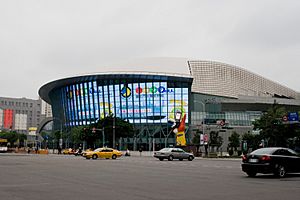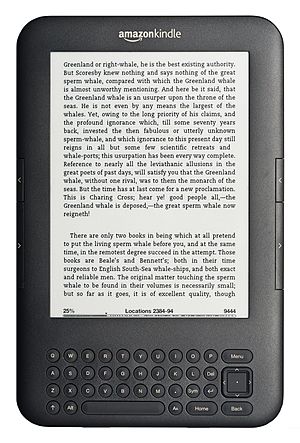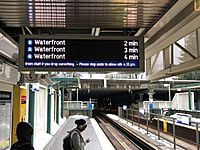Flat-panel display facts for kids
A flat-panel display (often called an FPD) is a type of electronic screen. It shows pictures, videos, and text. You can find them in many everyday devices. These include TVs, phones, computers, and even medical equipment.
Flat-panel displays are very thin and light. They offer clearer images and better detail than older, bulky screens like CRT TVs. Most are less than 10 centimeters (4 inches) thick. Modern flat-panel displays can show very high-quality pictures, like 1080p or even 4K resolution.
Since the 2010s, flat-panel displays have been popular in portable gadgets. Laptops, mobile phones, and cameras use them because they are light and save battery power. By 2016, flat-panel displays had mostly replaced older CRT screens.
Most flat-panel displays today use LCD (liquid-crystal display) or light-emitting diode (LED) technology. Sometimes, these technologies are even combined. Many LCD screens use a light behind them to show colors. Also, many flat-panel displays now have touch screens. This lets you interact with the screen directly, like on a smartphone. Modern smartphones often use OLED screens with capacitive touch screens.
Flat-panel displays can be split into two main types: volatile and static. Volatile screens need constant power to keep showing an image. If the power goes off, the picture disappears. liquid-crystal displays (LCDs) are an example of this. Static screens, like those using e-ink technology, can hold an image even without power. They only need power to change what's on the screen.
Contents
The History of Flat-Panel Displays
The idea for a flat-panel TV first came from General Electric in 1954. They were working on radar screens and published their findings. However, they didn't build a working flat panel at that time.
The first flat-panel display that was actually made was the Aiken tube. It was developed in the early 1950s and produced in small numbers in 1958. It was used in military systems, but it never became a commercial product for homes.
The Philco Predicta TV came out in 1958. It had a flatter screen than other TVs of its time. But it was not a big success. The plasma display panel was invented in 1964 at the University of Illinois.
How LCD Screens Were Developed
The MOSFET (a type of transistor) was invented in 1959 by Mohamed M. Atalla and Dawon Kahng. Building on this, Paul K. Weimer developed the thin-film transistor (TFT) in 1962. This was a key step for LCDs.
The idea for an LCD screen using TFTs came from Bernard J. Lechner in 1968. Later that year, the first active-matrix electroluminescent display (ELD) was made using TFTs. In 1973, the first thin-film-transistor liquid-crystal display (TFT LCD) was shown.
By 1982, small LCD TVs were being made in Japan. The 2.1-inch Epson ET-10 Epson Elf was the first color LCD pocket TV, released in 1984. In 1988, a Sharp team showed a 14-inch full-color LCD screen. This made the electronics industry believe that LCDs would replace older CRT TVs. Today, almost all modern high-quality screens use TFT-based active-matrix displays.
The Story of LED Displays
The first useful LED display was created by Hewlett-Packard (HP) in 1968. This came from research on LED technology between 1962 and 1968. In 1969, HP introduced the HP Model 5082-7000 Numeric Indicator. This was the first LED display that could show numbers and letters. It was a big change for digital display technology.
In 1987, Ching W. Tang and Steven Van Slyke at Eastman Kodak built the first practical organic LED (OLED) device. In 2004, the Sony Qualia 005 was the first TV with an LED-backlit LCD screen. The Sony XEL-1, released in 2007, was the first TV to use OLED technology.
Common Types of Flat-Panel Displays
Liquid-Crystal Display (LCD) Technology
LCDs are light, small, portable, and usually affordable. They are also easier on the eyes than older CRT screens. An LCD screen has a thin layer of liquid crystal. This special liquid is placed between two glass plates with clear electrodes. Two polarizing films are on each side of the LCD.
When an electric field is applied, parts of the liquid crystal change. This changes how light passes through them. Different types of LCDs use different ways to do this, like Twisted Nematic (TN) or In-Plane Switching (IPS). To create colors, tiny red, green, and blue filters are used for each pixel. LCD screens are found in many devices, such as watches, calculators, mobile phones, TVs, and computer monitors.
LED-LCD Displays
Many older, large LCD screens used CCFL (cold-cathode fluorescent lamps) for backlighting. However, smaller devices often used LEDs. Now, almost all new large screens use LED backlight technology. The picture itself is still made by the LCD layer.
Plasma Panel Displays
A plasma display has two glass plates with a small gap between them. This gap is filled with a gas like neon. Each plate has parallel electrodes. When a voltage is applied between electrodes on both plates, a small part of the gas glows. A lower voltage keeps the glow going. By 2010, many companies stopped making plasma displays for consumers.
Electroluminescent Panel Displays
In an electroluminescent display (ELD), the image is made when electrical signals are applied to plates. These signals make a special material called phosphor glow.
Organic Light-Emitting Diode (OLED) Displays
An OLED (organic light-emitting diode) is a type of LED. It has a thin film of organic material that glows when electricity passes through it. This organic layer is between two electrodes, and at least one of them is clear. OLEDs are used in many digital screens. You can find them in TVs, computer monitors, mobile phones, and handheld game consoles.
Quantum-Dot Light-Emitting Diode (QLED) Displays
QLED, or quantum dot LED, is a screen technology mainly known from Samsung. Other companies like Sony have also used quantum dots to improve the backlighting of LCD TVs since 2013. Quantum dots are tiny particles that create their own unique light when hit by a shorter wavelength light, like blue LEDs.
This technology makes the colors on LCD screens much richer. The image is still created by the LCD panel. Samsung believes that quantum dot displays will become more popular than OLED displays for large TVs. However, Samsung's own smartphones, like the Samsung Galaxy series, still use OLED screens. Samsung says their QLED TVs can figure out which parts of the screen need more or less contrast.
Volatile Displays

Volatile displays need to be constantly refreshed to keep showing an image. This happens many times every second. Even if the image on the screen is not changing, the screen still needs power. If the power goes out, the image will slowly disappear from the screen.
Examples of Volatile Displays
Here are some flat-display technologies that have been used from the 1990s to the 2010s:
- Plasma display panel (PDP)
- Active-matrix liquid-crystal display (AMLCD)
- Rear projection: Digital Light Processing (DLP), LCD, LCOS
- Light-emitting diode display (LED)
- Active-matrix organic light-emitting diode (AMOLED)
- Quantum dot display (QLED)
Some technologies were researched a lot but were not widely used:
- Active-matrix electroluminescent display (ELD)
- Interferometric modulator display (IMOD)
- Field emission display (FED)
Static Displays

Static flat-panel displays use materials that can hold their color state without needing constant power. This means the image stays on the screen even if the power is turned off. This makes them very energy-efficient. However, they often change images slowly, which isn't great for interactive screens.
Static displays are used in some specific products. Examples include cholesteric liquid-crystal displays for outdoor advertising and electrophoretic displays found in e-book readers like the Amazon Kindle.
See also
 In Spanish: Pantalla plana para niños
In Spanish: Pantalla plana para niños
- Computer monitor
- Display motion blur
- Electronic paper
- FPD-Link
- Flexible display
- Large-screen television technology
- LCD
- LED-backlit LCD television
- List of flat panel display manufacturers
- MicroLED
- Mobile display
- OLED
- Plasma display panel
- Quantum dot display
- Sony Watchman
- Stereoscopy 3D displays requiring no special glasses
- Touch panel
- Transparent display



